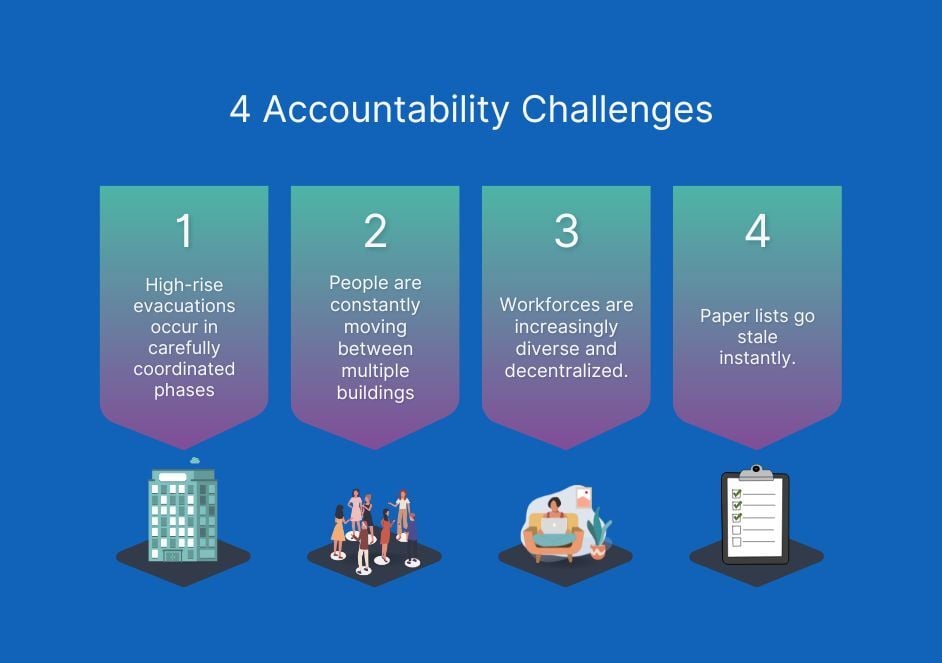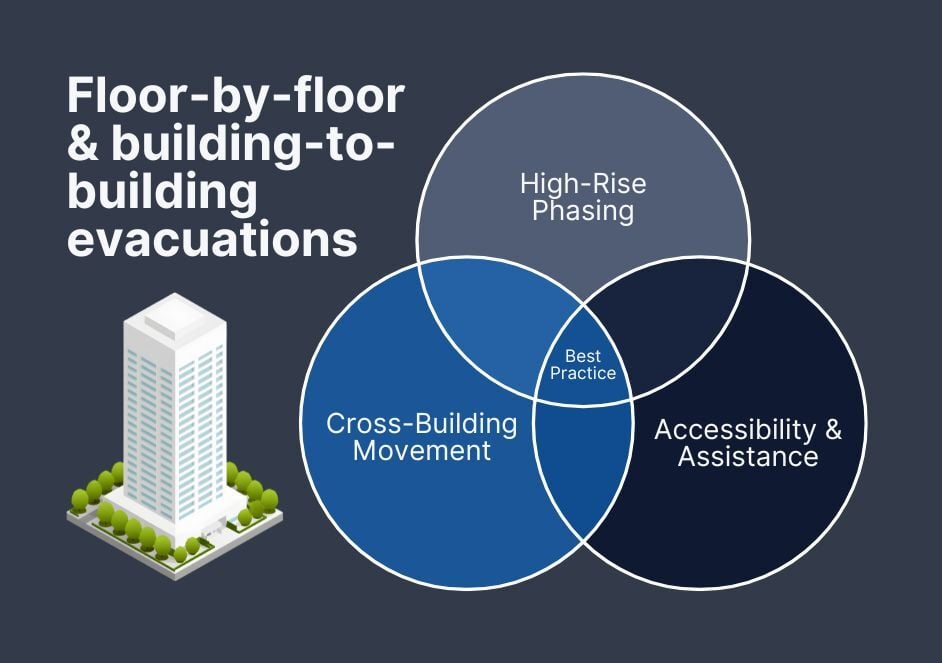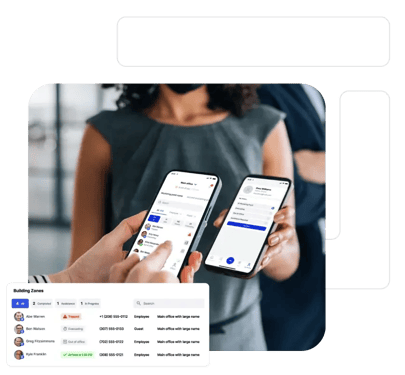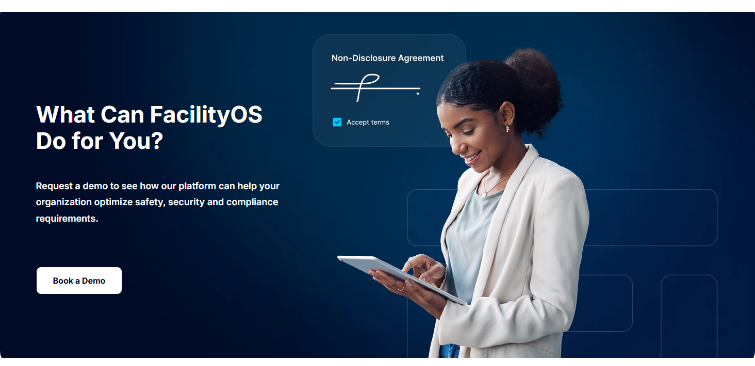High-Rise & Campus Evacuations: Real-Time Mustering Across Sites
When an alarm sounds in a high-rise or across a multi-building campus, every moment matters. Clear guidance, up-to-date headcounts, and confident team coordination make all the difference for a smooth, safe evacuation experience. The need is easy to understand—ensuring everyone is accounted for, whether they’re employees, contractors, visitors, or students, as people move between floors and buildings—but it’s no small feat to accomplish in real-world conditions.
This post outlines a practical approach to real-time mustering using mobile roll calls and automatic roster sync from your check-in systems, so safety teams can know who’s out, who’s missing, and where to focus next.
The Accountability Challenge in Complex Facilities

High-rise evacuations occur in carefully coordinated phases—often floor by floor—to maintain order and prevent congestion in stairwells. However, this phased approach, combined with multiple stairwells and the presence of designated re-entry floors, greatly increases the complexity of accurately tracking occupants. People may exit at different levels or use alternative stairwells, and some may temporarily return to safe zones before mustering at ground level. As a result, maintaining real-time, accurate headcounts becomes a challenging task, requiring dynamic rosters that can reconcile movement across multiple evacuation paths and prevent duplicate counts.
On sprawling campuses, people are constantly moving between multiple buildings and designated muster points, making it difficult to maintain a single, unified roster in real time. The dynamic flow across sites—students heading to another lecture hall, contractors finishing a job in a different wing, or employees assisting at another facility—creates gaps and overlaps that obscure an accurate headcount. As rosters fragment and individuals relocate, safety teams risk losing track of who is present at each muster point, leading to potential confusion and delays during critical moments.
Workforces are increasingly diverse and decentralized. Not everyone on-site—especially third-party contractors, service vendors, and daily visitors—will be represented in your organization’s HR or payroll systems. These individuals may be engaged for short-term projects, shift work, or on an ad-hoc basis, often bypassing traditional employee onboarding processes. This lack of consistent record-keeping in core HR systems means that many people present during an emergency may not appear on internal personnel lists, creating significant blind spots for safety teams responsible for mustering and accountability.
Paper lists go stale instantly. Printed rosters become obsolete the moment someone badges in, signs the visitor log, or changes location within the facility. Whether a contractor finishes a task and moves to a different building, or a visitor checks in at reception while employees are entering through another access point, static paper records fail to capture these updates in real time. As movement occurs, these lists drift further from reality—missing new arrivals, overlooking departures, and risking inaccuracies when it matters most. Relying on these outdated documents not only slows down emergency response, but also introduces uncertainty when safety teams need precise, up-to-the-second headcounts.
The result: precious minutes are lost as safety teams repeatedly verify names, conduct redundant headcounts at multiple muster points, and struggle to pinpoint a missing person’s last confirmed location. This fragmented process not only delays emergency response but also amplifies uncertainty, making it difficult for coordinators to determine whether someone is truly unaccounted for or simply recorded incorrectly on outdated lists.
What “Real-Time Mustering” Actually Means
Real-time mustering aligns three things: immediate roster accuracy, situational context, and clear assignment of accountability. Live rosters show employees, visitors, and contractors in one view, sourced from systems your site already uses, like access control, time and attendance, and visitor management. This delivers current headcounts as people move and ensures non-employees are included in communications.
At the same time, mustering tools provide context on status and progress: coordinators can run digital roll calls at one or many muster points and verify who has checked in, who is missing, and who needs help. Messaging keeps evacuees and Safety Officers connected during the event.
Finally, real-time mustering creates accountability with centralized records: every action is captured for evacuation reports and a digital event log, so teams can review performance and meet audit requirements across facilities.
Live Rosters
Pull the latest people data from on-site systems that know who is present right now:
- Access control and time and attendance systems
- Visitor and contractor sign-ins from your visitor management system, including pre-registration where enabled
This keeps one up-to-date list of everyone potentially impacted.
Mobile Roll Calls
Give Safety Officers a digital mustering list they can use at designated muster points to mark people accounted or needing assistance, while filters surface anyone still unaccounted for. Multiple muster points are supported, with data stored in one central location.
Multi-Site Visibility & Records
Provide leadership and coordinators a unified view across facilities and muster points to monitor progress in real time, verify personnel, and generate post-event evacuation reports and time-stamped digital records.
Floor-By-Floor & Building-To-Building Evacuations

High-Rise Phasing
During high-rise evacuations, live rosters are automatically segmented to match the current active phase, focusing accountability on only the floors being evacuated at that moment. As each phase completes and floors are cleared, the system seamlessly transitions to the next set, updating assignments so wardens and safety teams always have an accurate, real-time roster for their area of responsibility.
This prevents double-counting by ensuring individuals are only tracked within their current phase and avoids confusion as people move between stairwells or muster points. Phased progression ensures headcounts remain precise and up to date, allowing teams to maintain clear accountability at every step of the evacuation sequence.
Cross-Building Movement
Effective mustering should adapt in real-time as conditions change. When a muster point becomes crowded or unsafe due to smoke, weather, or an obstruction, coordinators can redirect groups to designated secondary or overflow areas. The system supports multiple muster points with a single, centralized mustering list and digital roll calls, so these changes are managed without juggling paper rosters.
As people are directed to new locations, the unified roster updates with their latest status. Safety teams can verify personnel at muster points, see who is accounted for, and focus attention on anyone still missing. Real-time messaging helps coordinators communicate instructions quickly to employees, visitors, and contractors.
This approach reduces confusion and duplicate effort, helping maintain accurate headcounts as occupants move between buildings or zones. After the event, evacuation reports and a digital record capture what happened for audits and continuous improvement.
Accessibility & Assistance
Promptly identify people who need extra support during an evacuation using live status signals in the mustering tools. Participants can reply to an SMS with “Assistance Required,” and Safety Officers can update statuses during digital roll calls. The app filters the roster to surface those who need help, have not responded, or are still unaccounted for, so wardens can act without digging through separate systems.
Because employees, contractors, and visitors are included in one real-time list and communication flow, coordinators can move faster, notify hosts about their signed-in guests, and keep everyone informed. Visitor records and notes are stored in VisitorOS for context when needed. This supports targeted actions like sending specific instructions or dispatching extra personnel, while evacuation reports and digital event logs preserve a time-stamped audit trail.
Automatic Roster Sync: Where the Data Comes From
For employees, real-time on-site status is established through automated, integrated sources such as access control badge events, system presence, and scheduled shifts. When someone enters or exits through monitored points, those events update the live roster instantly so headcounts stay current without manual tallying. During emergencies, safety teams can view a single, up-to-date list of employees, visitors, and contractors and run digital roll calls to confirm accountability. Post-incident, the system retains a complete digital record for reporting and audits.
Contractors are tracked through integrated check-ins and compliance workflows that confirm who is authorized to be on-site. As contractors arrive, complete required materials, or move between locations, their status updates in real time so only credentialed individuals appear on the active muster list. This reduces blind spots and supports faster follow-up if a certification lapses or a requirement is missed.
FacilityOS visitor management streamlines rosters by ensuring every guest, whether pre-registered or checking in at the lobby, is automatically added to the live mustering list—complete with host assignment and stated visit purpose. Visitors are included automatically whether they pre-register or check in at a kiosk. Their sign-in and sign-out events, host assignment, and visit details flow into the same live view that safety uses during musters. Visitor activity forms a searchable audit trail with scheduled reports, which improves readiness for internal reviews and regulatory audits.
Your roster of record should be the check-in and access systems people already use. Real-time mustering consolidates those sources into one authoritative list so safety teams can act quickly without copying data across binders or spreadsheets. Live visibility, digital roll calls, and evacuation reporting make it easier to account for everyone across buildings, zones, and muster points, then produce a clean record when the event ends.
By dynamically unifying all on-site population data, the system eliminates outdated paper rosters and fragmented spreadsheets, giving your organization the operational confidence to respond decisively, even as people move between buildings, zones, or muster points during an incident.
How Mobile Roll Call Works In Practice
Here’s how key workflows are handled from both the warden’s perspective and the command center:
- Wardens are assigned to specific floors or buildings. Their view shows only the people they’re responsible for.
- During an evacuation, wardens perform quick swipes to mark status and add notes for exceptions.
- If someone scans out at a turnstile, that person auto-flips to “Accounted” across all lists to prevent rework.
- If multiple wardens attempt to account for the same person, the system resolves duplicates and keeps a single truth with timestamps.
- The command center sees lagging muster points and can dispatch support where it’s needed most.

These capabilities empower safety teams to maintain clarity and control throughout an incident.
By combining precise role assignments with real-time data capture, organizations ensure everyone is accurately represented—minimizing confusion and speeding decision-making when every second counts.
Offline-First & Resilience
Emergencies often disrupt networks. Mobile roll call should function without signal: Reliable accountability cannot depend on Wi-Fi or cellular coverage—especially when infrastructure may be compromised during fire alarms, severe weather, or security incidents.
That’s why mobile roll call solutions must support full offline operation. Wardens should be able to access cached rosters, mark statuses, add notes, and capture scans locally on their device, all without network connectivity. Data is securely stored on the device and automatically reconciled with the master roster when connectivity returns, ensuring that no updates are lost and every action is accounted for. This offline-first resiliency not only protects the roll call process from unpredictable network outages but also reinforces trust that headcounts remain accurate, even in the most challenging conditions. Look for a solution that offers:
- Cached rosters with last-sync timestamps
- Local marking with conflict resolution on reconnect
- QR or badge scanning that stores results offline
- Visual indicators when data is stale and when sync completes
Compliance, Audit Trails, & After-Action Reports
Evacuations are not only about real-time response, they’re also about demonstrating that every reasonable action was taken, both in the moment and after the fact. Beyond ensuring immediate safety, organizations must be able to produce a precise, time-stamped account of who was present, where they were mustered, and how each person’s status was verified throughout the incident. This record of diligence is essential for internal reviews, regulatory compliance, insurance requirements, and building trust with stakeholders. Robust audit trails, populated automatically as mustering activities occur, provide indisputable evidence that protocols were followed and every individual on site was accounted for according to policy—transforming emergency management from a reactive task to a proactive, defensible process.
Ensure you look for a solution that offers:
- Time-stamped events for each person’s status changes
- Who performed the check, where, and on which device
- Attachments and notes for special circumstances
- Exportable reports for regulators, insurers, and internal safety committees
Implementation Checklist
To translate proven mustering principles into daily readiness and reliable compliance, consider the practical checklist below. These core steps anchor real-time accountability by connecting your people, processes, and systems—enabling your teams to respond swiftly, maintain clear oversight, and produce the records regulators and stakeholders expect after any incident. Use this list as a blueprint to streamline your rollout and ensure lasting operational confidence.
- Map data sources - Identify your systems of record for employees, contractors, and visitors. Confirm field mappings and update frequency.
- Define muster structure - List buildings, floors, zones, and muster points. Assign wardens and backups to each.
- Configure roles and filters - Ensure each warden’s mobile view shows only what they own. Set up the command view for aggregated oversight.
- Test phased scenarios - Run drills that mimic phased high-rise evacuations and cross-building relocations. Validate duplicate prevention and reassignment flows.
- Validate offline behavior - Simulate loss of connectivity and confirm that roll calls remain usable and reconcile cleanly.
- Train and iterate - Keep training lightweight. Use short, scenario-based refreshers. Tune labels and workflows based on drill outcomes.
FAQs
How do you handle visitors with no badge?
Visitor management check-ins add guests to the roster with a scannable QR or simple name search in mobile roll call.
What if a contractor’s credentials expire mid-day?
The person remains visible if on site, but is flagged for follow-up. Accountability never disappears just because status changed.
Can wardens add someone who wasn’t on the list?
Yes. Ad-hoc additions are allowed with notes, and reconciled later against source systems.
What if two muster points try to account for the same person?
The system resolves duplicates automatically, keeping the earliest valid check and logging both attempts for audit.
The Outcome
With automatic roster sync and mobile roll calls, high-rise and campus evacuations move from guesswork to a shared operational picture. Wardens stay focused on people, not paperwork. Safety leaders get real-time clarity across sites. And organizations leave every drill or incident with the evidence to prove it.
If you want help adapting this approach to your buildings, muster structure, and existing check-in systems, say the word and we can outline a tailored rollout plan.
Stay updated with industry insights, success stories, and more by following us on social media for the latest FacilityOS content.
Table of Contents





 Follow us on Facebook
Follow us on Facebook  Follow us on X
Follow us on X
 Follow us on LinkedIn
Follow us on LinkedIn